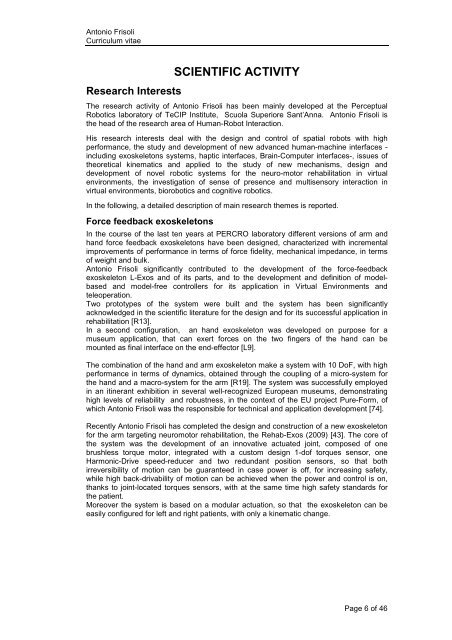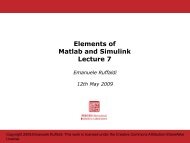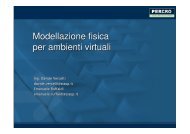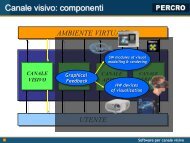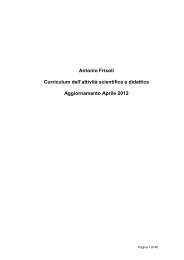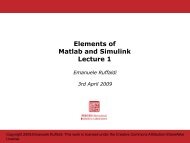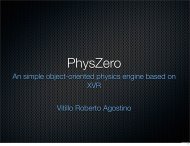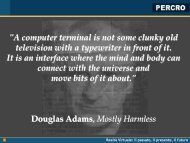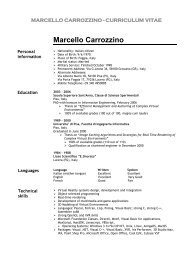English - Percro - Scuola Superiore Sant'Anna
English - Percro - Scuola Superiore Sant'Anna
English - Percro - Scuola Superiore Sant'Anna
You also want an ePaper? Increase the reach of your titles
YUMPU automatically turns print PDFs into web optimized ePapers that Google loves.
Antonio Frisoli<br />
Curriculum vitae<br />
Research Interests<br />
SCIENTIFIC ACTIVITY<br />
The research activity of Antonio Frisoli has been mainly developed at the Perceptual<br />
Robotics laboratory of TeCIP Institute, <strong>Scuola</strong> <strong>Superiore</strong> Sant’Anna. Antonio Frisoli is<br />
the head of the research area of Human-Robot Interaction.<br />
His research interests deal with the design and control of spatial robots with high<br />
performance, the study and development of new advanced human-machine interfaces -<br />
including exoskeletons systems, haptic interfaces, Brain-Computer interfaces-, issues of<br />
theoretical kinematics and applied to the study of new mechanisms, design and<br />
development of novel robotic systems for the neuro-motor rehabilitation in virtual<br />
environments, the investigation of sense of presence and multisensory interaction in<br />
virtual environments, biorobotics and cognitive robotics.<br />
In the following, a detailed description of main research themes is reported.<br />
Force feedback exoskeletons<br />
In the course of the last ten years at PERCRO laboratory different versions of arm and<br />
hand force feedback exoskeletons have been designed, characterized with incremental<br />
improvements of performance in terms of force fidelity, mechanical impedance, in terms<br />
of weight and bulk.<br />
Antonio Frisoli significantly contributed to the development of the force-feedback<br />
exoskeleton L-Exos and of its parts, and to the development and definition of modelbased<br />
and model-free controllers for its application in Virtual Environments and<br />
teleoperation.<br />
Two prototypes of the system were built and the system has been significantly<br />
acknowledged in the scientific literature for the design and for its successful application in<br />
rehabilitation [R13].<br />
In a second configuration, an hand exoskeleton was developed on purpose for a<br />
museum application, that can exert forces on the two fingers of the hand can be<br />
mounted as final interface on the end-effector [L9].<br />
The combination of the hand and arm exoskeleton make a system with 10 DoF, with high<br />
performance in terms of dynamics, obtained through the coupling of a micro-system for<br />
the hand and a macro-system for the arm [R19]. The system was successfully employed<br />
in an itinerant exhibition in several well-recognized European museums, demonstrating<br />
high levels of reliability and robustness, in the context of the EU project Pure-Form, of<br />
which Antonio Frisoli was the responsible for technical and application development [74].<br />
Recently Antonio Frisoli has completed the design and construction of a new exoskeleton<br />
for the arm targeting neuromotor rehabilitation, the Rehab-Exos (2009) [43]. The core of<br />
the system was the development of an innovative actuated joint, composed of one<br />
brushless torque motor, integrated with a custom design 1-dof torques sensor, one<br />
Harmonic-Drive speed-reducer and two redundant position sensors, so that both<br />
irreversibility of motion can be guaranteed in case power is off, for increasing safety,<br />
while high back-drivability of motion can be achieved when the power and control is on,<br />
thanks to joint-located torques sensors, with at the same time high safety standards for<br />
the patient.<br />
Moreover the system is based on a modular actuation, so that the exoskeleton can be<br />
easily configured for left and right patients, with only a kinematic change.<br />
Page 6 of 46


